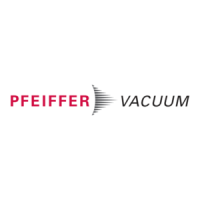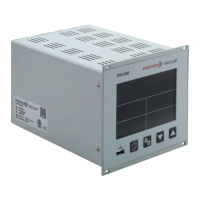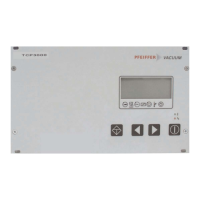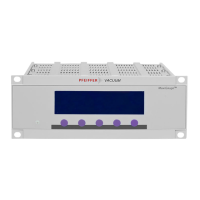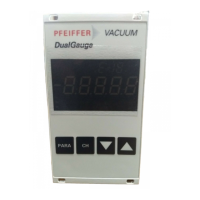Do you have a question about the Pfeiffer Vacuum TC 110 and is the answer not in the manual?
Defines the scope and applicability of the operating instructions.
Lists related documents and their status within the manual.
Identifies the intended audience and their qualifications for using the product.
Explains text and symbol conventions used throughout the document.
Outlines general safety guidelines and risk levels (DANGER, WARNING, CAUTION, NOTICE).
Provides specific safety instructions related to installation and electrical hazards.
Details precautions for safe handling, potential dangers, and conformity.
Guides on how to identify the product using rating plates and certifications.
Lists key features and variants of the TC 110 electronic drive unit.
Lists items included in the TC 110 product package.
Describes PV.can, X3 interfaces, and LED indicators on the electronic drive unit.
Illustrates electrical connections and includes safety warnings for installation.
Details the 15-pin D-sub connection for remote control and its factory settings.
Explains the RS-485 interface for communication with control units or PCs.
Shows different connection configurations for the RS-485 interface.
Illustrates networking configurations using RS-485 connection cables.
Details the Pfeiffer Vacuum communication protocol structure used over RS-485.
Defines the structure and components of the communication telegrams.
Introduces parameters, their storage, and how they are used.
Lists and explains parameters used for controlling pump functions like heating and standby.
Lists parameters used for querying the status of the electronic drive unit.
Describes parameters for configuring operational setpoints and values.
Explains additional parameters available via Pfeiffer Vacuum display and control units.
Details how to configure digital inputs using the parameter set.
Lists options for configuring digital inputs and their corresponding parameters.
Lists options for configuring digital outputs and their functions.
Explains how to configure the analog output signal.
Details how to configure accessory outputs and connections.
Describes options for selecting active communication interfaces.
Introduces various operating modes for the turbopump.
Explains how gas type affects operation and the need for correct parameter settings.
Details how to adjust power consumption settings and their effect on run-up time.
Explains the time-monitored run-up process and causes of prolonged times.
Describes how to use rotation speed switch points for process messages and signals.
Explains how to reduce speed and its effect on pumping and status signals.
Recommends standby mode for downtime and explains its function.
Details the process of confirming nominal rotation speed for safety.
Explains different operating modes for connected backing pumps.
Describes how to configure backing pump standby mode using digital outputs.
Provides information on using Pfeiffer Vacuum accessories.
Explains different venting modes available after pump shutdown.
Details the procedure for starting the turbopump and connected accessories.
Outlines the procedure for safely shutting down the turbopump.
Explains how to monitor the pump's operating status using LEDs.
Describes the meaning of LED status indicators on the drive unit.
Discusses temperature monitoring and its impact on safe operation.
Provides general warnings about malfunctions and error reporting.
Lists and explains various error codes and their possible causes and remedies.
Details additional error and warning messages displayed when using a DCU.
Defines the scope and applicability of the operating instructions.
Lists related documents and their status within the manual.
Identifies the intended audience and their qualifications for using the product.
Explains text and symbol conventions used throughout the document.
Outlines general safety guidelines and risk levels (DANGER, WARNING, CAUTION, NOTICE).
Provides specific safety instructions related to installation and electrical hazards.
Details precautions for safe handling, potential dangers, and conformity.
Guides on how to identify the product using rating plates and certifications.
Lists key features and variants of the TC 110 electronic drive unit.
Lists items included in the TC 110 product package.
Describes PV.can, X3 interfaces, and LED indicators on the electronic drive unit.
Illustrates electrical connections and includes safety warnings for installation.
Details the 15-pin D-sub connection for remote control and its factory settings.
Explains the RS-485 interface for communication with control units or PCs.
Shows different connection configurations for the RS-485 interface.
Illustrates networking configurations using RS-485 connection cables.
Details the Pfeiffer Vacuum communication protocol structure used over RS-485.
Defines the structure and components of the communication telegrams.
Introduces parameters, their storage, and how they are used.
Lists and explains parameters used for controlling pump functions like heating and standby.
Lists parameters used for querying the status of the electronic drive unit.
Describes parameters for configuring operational setpoints and values.
Explains additional parameters available via Pfeiffer Vacuum display and control units.
Details how to configure digital inputs using the parameter set.
Lists options for configuring digital inputs and their corresponding parameters.
Lists options for configuring digital outputs and their functions.
Explains how to configure the analog output signal.
Details how to configure accessory outputs and connections.
Describes options for selecting active communication interfaces.
Introduces various operating modes for the turbopump.
Explains how gas type affects operation and the need for correct parameter settings.
Details how to adjust power consumption settings and their effect on run-up time.
Explains the time-monitored run-up process and causes of prolonged times.
Describes how to use rotation speed switch points for process messages and signals.
Explains how to reduce speed and its effect on pumping and status signals.
Recommends standby mode for downtime and explains its function.
Details the process of confirming nominal rotation speed for safety.
Explains different operating modes for connected backing pumps.
Describes how to configure backing pump standby mode using digital outputs.
Provides information on using Pfeiffer Vacuum accessories.
Explains different venting modes available after pump shutdown.
Details the procedure for starting the turbopump and connected accessories.
Outlines the procedure for safely shutting down the turbopump.
Explains how to monitor the pump's operating status using LEDs.
Describes the meaning of LED status indicators on the drive unit.
Discusses temperature monitoring and its impact on safe operation.
Provides general warnings about malfunctions and error reporting.
Lists and explains various error codes and their possible causes and remedies.
Details additional error and warning messages displayed when using a DCU.
| Brand | Pfeiffer Vacuum |
|---|---|
| Model | TC 110 |
| Category | Control Unit |
| Language | English |
